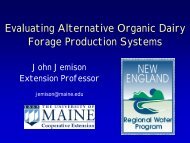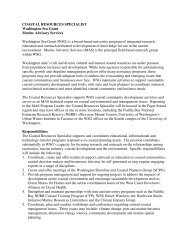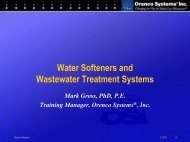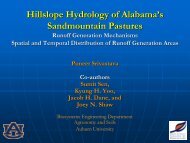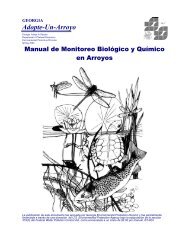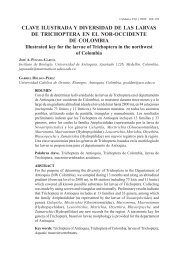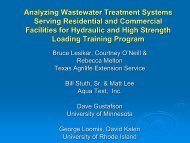Mid-Atlantic Drinking Water/Master Well Owner Network
Mid-Atlantic Drinking Water/Master Well Owner Network
Mid-Atlantic Drinking Water/Master Well Owner Network
Create successful ePaper yourself
Turn your PDF publications into a flip-book with our unique Google optimized e-Paper software.
Need for support and resources Private water supply users areresponsible for: Routine testing to ensure safe water fordrinking and cooking Care and maintenance of system Solving water problems Often lack knowledge and resourcesto make well‐informed decisions Many wait until problem arises totake actionPhoto credits: Fenton <strong>Well</strong> and Pump; Penn State University
Overview of private water supplies <strong>Well</strong>s Drilled or bored Range from 20‐1000’ feetdeep Locate at least 100’ fromsources of contamination Casing, grouting, sanitary wellcap protect well from surfacewater contamination<strong>Well</strong> capCasingGroutPhoto credit: A Guide to Private <strong>Water</strong> Systems in Pennsylvania: A manual for Rural Homeowners on theProper Construction and Maintenance of Private <strong>Well</strong>s, Springs and Cisterns; Rorrer <strong>Well</strong> Drilling, Inc.
Overview of private water supplies Springs Formed when the side of a hill,valley bottom or otherexcavation intersectsgroundwater Highly susceptible tocontamination Cisterns Collection and storage ofrainwater, often from rooftopPhoto credit: http://aquariuspump.com/springbox.aspx
The <strong>Master</strong> <strong>Well</strong> <strong>Owner</strong> <strong>Network</strong> (MWON) Train‐the‐trainer approach; based on <strong>Master</strong> Gardener model Initiated in Pennsylvania in 2003; Virginia in 2007with USDA‐CSREES Extension Education Grants Volunteers and extension agents complete1‐2 day training and commit to outreachRorrer <strong>Well</strong> Drilling, Inc.http://geoscape.nrcan.gc.ca/h2o/bowen/underground_e.phphttp://finance.varolmak.com/2010/01/water-softener-revhttp://www.thedailygreen.com/green-homes/latest/waiews-user-reviews.htmlter-conservation-tips-5-saversPhoto credit: Penn State University Topics covered: Groundwater <strong>Well</strong> construction and maintenance Land use impacts <strong>Water</strong> testing Conservation Solving water problems/treatmentBrine Tank<strong>Water</strong> Softener(resin)
The <strong>Master</strong> <strong>Well</strong> <strong>Owner</strong> <strong>Network</strong> (MWON) MWON Volunteer expectations Complete training workshop Achieve 80% on post‐test Agree to try to reach 100 contacts over 2 years Volunteer only; cannot own or work for companydealing with private water supplies Many approaches for outreach One‐on‐one conversations Speaking to church or civic groups Booth at home shows or ag fairsPhoto credit: Penn State University
MWON Supporting ResourcesCooperative extension publicationsbrochureswebsites and online toolsvolunteer outreach resources:posters, groundwater modelsinstructionalvideosnewsletters
<strong>Drinking</strong> water clinics Offer drinking water testing and education toprivate water supply users Test result interpretation Recommendations for care of water systems Conducted by faculty and extension agents Over 10,000 participants regionally since 2004Photo credit: Virginia Tech, Delaware State University
<strong>Drinking</strong> water clinics: Selected impacts In Virginia: 20‐40% of samples in each county test positive for coliform bacteria 82% of participants will test regularly after participating in clinic Efforts to reach underserved populations including elderly and lowincome Clinic participants often become MWON volunteers In Maryland‐Eastern Shore Of 45 samples tested on Delmarva Peninsula, 66% tested positive for totalcoliform; 40% positive for E. coli 86% increase in knowledge on post‐test administered to clinic participants Half of participants never had water tested; Half believed water wastested once before
The Proven MWON modelInitial fundingDedicated state MWONCoordinatorCreate/adapt educationalresourcesRecruit, train,engage, andretain MWONvolunteers andextension agentsImpact:thousands ofprivate watersupply userseducatedExperienced MWONcoordinators mentornew coordinators
MWON Impacts700 volunteers andextension agents trained27,000+ educational contactsIn PA, 76% of MWONeducational contacts havetaken action to improve theirwater supplyIn VA, 30 MWON trainedextension agents haveconducted drinking waterclinics in 27 counties reaching1400 people since 2009.Photo credit: Virginia Tech
Recognition and Replication2006 Groundwater Protection Award2007 Universities’ Council on <strong>Water</strong>Resources Education andPublic Service AwardMWON model replicatedin the Southern Regional<strong>Water</strong> Quality ProgramStephanie Clemens, PennsylvaniaMWON Coordinator, discussesMWON successes in 2007.Photo credit: Penn State University
PartnersUSDA‐NIFA<strong>Mid</strong>‐<strong>Atlantic</strong> <strong>Water</strong> ProgramU.S. Geological Service EPA Region 3Penn State UniversityVirginia TechDelaware State UniversityUniv. of Maryland Eastern ShoreUniversity of DelawareUniversity of MarylandVirginia State UniversityVirginia Cooperative ExtensionPennsylvania Cooperative ExtensionMaryland Cooperative ExtensionVirginia Dept of HealthPennsylvania Dept of HealthPennsylvania Dept of Envt ProtectionDelaware Dept of Natural ResourcesCollaboration Pennsylvania of Groundwater 1862 and 1890 Assnland grant institutions critical toVirginia <strong>Water</strong> <strong>Well</strong> AssnMWON success!Delaware/Maryland <strong>Water</strong> <strong>Well</strong> AssnIndividual/private companies
USDA National <strong>Water</strong> Program SupportWithout funding from USDA these activitiescould not have been piloted andimplemented in the <strong>Mid</strong>‐<strong>Atlantic</strong>.The National <strong>Water</strong> Program played a criticalrole in the success of the MWON modelbeing replicated within and across regions.
Plans for the future…. Grant proposal under development to expand andstrengthen MWON in the <strong>Mid</strong>‐<strong>Atlantic</strong> region Development of online, continuing educationmodules: emerging contaminants septic system care and maintenance water quantity, etc. MWON model continually adapted to meetspecific needs of private water supply users ineach state
Adapting MWON to meet specific needsVA: Efforts to build publichealth componentinto MWON includeoffering continuingeducation toDepartment ofHealth specialists andreal estate agents tomaintain licensure.http://completewellbeing.com/article/water-borne-diseases/
http://www.wayneindependent.com/the_villager/x124624223/Restoring-fed-reg-of-gas-drilling-praised-booed;http://dearsusquehanna.blogspot.com/2010/08/whatchesapeake-claims-is-crock.htmlAdapting MWON to meet specific needsPA:Marcellus shalegas drilling andpotentialgroundwatercontaminationhave spurredhundreds to take newinterest ingroundwaterprotection
Adapting MWON to meet specific needsMD: Military BaseRealignment andClosing is resulting inmany new familiesmoving to Marylandcreating demand foroutreach about wellsand septic systemsto new private watersupply users.http://www.louisebeckproperties.com/buying-home-new
Larger implicationsPrivate wells are a conduit to groundwater: poormanagement may result in contamination of otherprivate and public suppliesPhoto credit: National Groundwater Association
Larger implicationsMWON education and outreach providesgroundwater protection for private and publicwater supply users!Photo credit: National Groundwater Association
Thank you!Erin James LingVirginia MWON Coordinatorwellwater@vt.edu540‐231‐9058Daphne Pee<strong>Mid</strong>‐<strong>Atlantic</strong> <strong>Water</strong> Program Liaisondpee@umd.edu301 405‐5849http://omafra.gov.on.ca/



